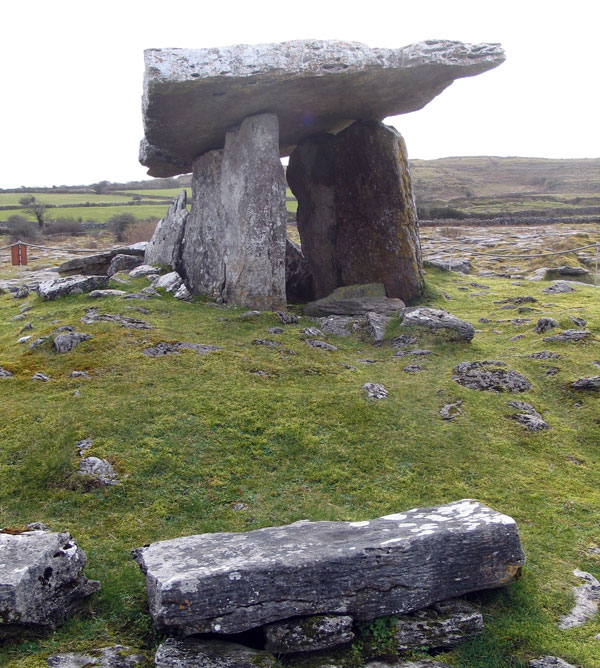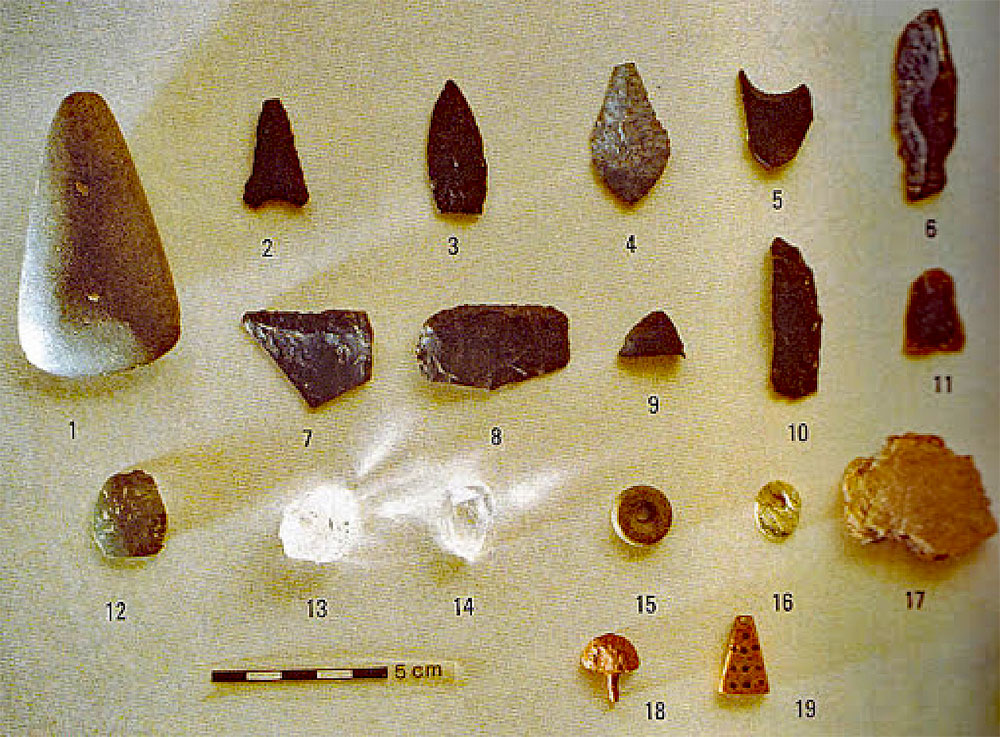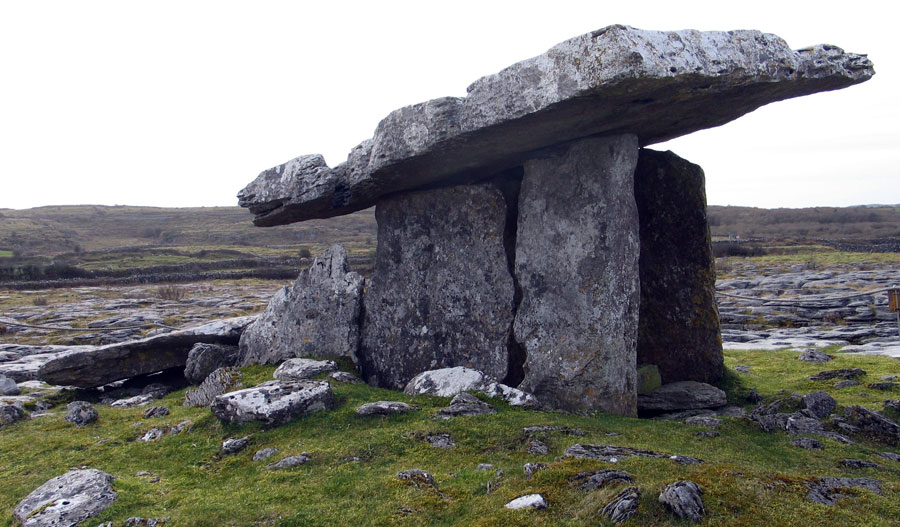Poulnabrone
The Poulnabrone dolmen is probably the most photographed of all the megalithic monuments to be found in Ireland. It is certainly one of the most beautiful and graceful of the Irish portal dolmens; with it's elegant soaring capstone the monument has often been compared to a bird in flight.
The name, Poulnabrone is often said to mean Hole of the Sorrows, and may come from a folk memory of the myth of Diarmuid and Grainne. This pair of mythical lovers were hunted around Ireland for sixteen years by Fionn Mac Cumhail, and many dolmens are named after them, as they had a habit of sleeping in megalithic structures to hide from the fury of Fionn. However, Poulnabrone actually means Hole of the Quernstone.
Rescue excavations in 1987 made a number of interesting discoveries. Poulnabrone is currently the oldest dated neolithic monument in Ireland, having been constructed around 3,800 BC and used for some 600 years for burial. You can watch an absolutely fascinating lecture on the excavation by Ann Lynch, linked below.
The presentation ‘Poulnabrone, a tomb for the ancestors’ includes an account of the excavations carried out at this iconic site in the late 1980s. The excavation revealed well-preserved human remains and the artefacts deposited with them which have provided insights into the builders of these little-understood monuments. A comprehensive dating programme has been carried out which places Poulnabrone at the very beginning of megalith building in Ireland. The results of recent research into ancient DNA will also be presented. Dr. Ann Lynch, a graduate of University College Cork and the Universiteit van Amsterdam, worked as an archaeologist with the National Monuments Service for almost 40 years. Her duties included working with architectural colleagues on the conservation of the monuments in state ownership and this resulted in her directing excavations at many of Ireland’s premier monuments including Dublin Castle, Newgrange, Skellig Michael, Tintern Abbey and of course, Poulnabrone portal tomb. This talk was organised by Burrenbeo Trust, a local landscape charity with no core funding. Please do consider supporting the Trust through membership or donations at burrenbeo.com.
Ann Lynch's Excavations
The dolmen is the remaining portion of a large chamber which stands within a low cairn, traces of which can still be seen around the monument. In the mid 1980's, the badly cracked structural slab on the northeast side of the monument looked ready to collapse, and the site was excavated by Ann Lynch.
The excavation of the chamber and part of the surrounding cairn revealed much about the form and structure of the tomb. The orthostats of the chamber were sitting directly on the limestone bedrock, held in place by the weight of the capstone like a house of cards. The sill-stone at the entrance to the chamber was sitting in an east-west gryke (a crevice in the limestone pavement) which formed a natural socket. Its original height is impossible to determine since it fractured at some stage in antiquity close to the present floor level, but it may have extended to the underside of the capstone, thereby effectively closing off the burial chamber. At the entrance to the chamber, just outside the sill-stone, three stones had been placed on edge forming a portico or antechamber which had been backfilled with earth and stones shortly after construction. The function of this feature is unclear but it neatly delimited the cairn edge at the tomb entrance.
Poulnabrone: A Stone in Time... Ann Lynch, 1988.
A special timber construction was built around the monument which was used to raise the capstone slightly to enable the damaged stone to be removed and the chamber to be safely excavated.
The cairn itself is roughly oval in plan and extends for three meters on average from the chamber. It was constructed by piling large slabs of limestone against the chamber orthostats and covering the whole with smaller flat stones to produce a relatively smooth surface sloping down to the limestone pavement. Some soil was incorporated in the cairn matrix and several large stones had been placed on edge in grykes to help stabilise the structure. No kerbstones were located.
It seems reasonable to assume that when originally built the cairn at Poulnabrone appeared much as it does today. The regular, well-finished appearance of the cairn surface suggests little disturbance over the centuries, and the coincidence of the top of the portico stones with the upper surface of the cairn suggests that this represents the maximum height (55cm above bedrock) of the cairn at this point. It would seem that the soaring capstone was designed to be seen and that the cairn served a strictly functional purpose in helping to consolidate the chamber orthostats.
Poulnabrone: A Stone in Time... Ann Lynch, 1988.

During the dig, the bones of 36 people - 19 adults and 17 younger people were found, including one infant. The bones were disarticulated, and about 15,000 fragments were found, pushed into the grykes at the bottom of the chamber. The adults included a man with a flint arrow embedded in his hip. None of the adults were over 40 years of age, and many showed signs of arthritis and badly worn teeth. A number of parts of skulls were found, and these were arranged around the edges of the chamber, something which was also found in some of the burial chambers in Orkney.

The number of individuals interred at Poulnabrone can hardly represent a Neolithic community, so we must regard the tomb as a place for special dead. Objects which must have been of particular significance to these people were placed in the tomb with their remains and included a bone pendant, part of a mushroom-headed bone pin, a polished stone axe, two stone disc-beads, two large quartz crystals, flint and chert scrapers, and projectile points. Over sixty sherds of undecorated coarse pottery were also recovered from the burial deposit. Artefacts recovered from the cairn include a polished bone point, five sherds of pottery and a possible hammerstone.
Poulnabrone: A Stone in Time... Ann Lynch, 1988.

This type of monument generally date to around 4000 BC; the bones excavated at Poulnabrone were dated from between 3800 and 3200 BC. Finds included fragments of pottery mixed in with the human bones and the bones of several types of animals, thought to indicate feasting. A number of stone tools were found: a small polished stone axe head, several flint arrowheads, flint scrapers, some stone beads and the head of a bone pin. Two small pieces of clear rock crystal were found, which is interesting, as it is more usual to find chunks of milky white quartz in megalithic monuments.
Poulnabrone: A Stone in Time... Ann Lynch, 1988.
Video caption:
There are a little less than 200 portal tombs surviving in Ireland, and Poulnabrone in County Clare is seen by many as the classic example of this form of megalithic tomb. It comprises a stone chamber with a pair stones at the north end forming an entrance or portal, hence the term portal tomb. These portal stones are tall, so that the large capstone is raised high above the entrance and falls gradually towards the rear of the chamber. Poulnabrone sits on a limestone plateau in the Burren, a name that derives from the Irish word boireann, meaning a rocky place.
This landscape of bare rock and terraced hillsides has its origins in the carboniferous period over 300 million years ago. Now standing high above the surrounding countryside, it was formed in the warm, shallow seas of the Carboniferous ocean. It emerged from the seabed over 50 million years, and a layer of shale that shielded the limestone for millions of years was eventually removed during the ice age. Today the tomb appears to be growing out of the rock, as if it is in tune with the environment around it.
However, when the tomb was originally constructed, the landscape here looked very different. Pollen studies have shown that the area was densely forested with oak and hazel at the time the tomb was constructed during the Neolithic. The tomb sits on the exposed limestone pavement, but we know that there was about 25cm of soil cover over the rock at the time it was constructed. When the first farmers began to clear the woodland to create their fields nearly 6000 years ago, this contributed to the large-scale erosion of the soil that has taken place here over the intervening millennia.
Despite the dramatic erosion of the overlying topsoil throughout this area, when it was excavated in the 1980s, archaeological remains were still preserved within a thin layer of soil within the chamber, and the fissures within the underlying bedrock. The excavations found the remains of at least 35 individuals buried within the chamber of the tomb. These represented both male and female as well as a wide range of age groups. The excavations also uncovered sherds of pottery, stone tools, including a polished stone axehead, as well as bone and stone pendants – that were probably deposited in the tomb as grave goods with the deceased.
Radiocarbon dating of the remains suggest that the tomb was built around 5800 years ago and continued to be used as a place of burial for around 600 years. One of the oldest monuments known in the Burren, Poulnabrone has become symbolic of one of the richest archaeological landscapes in the country, and across the world, this remarkable megalithic tomb has become an iconic image of early prehistoric Ireland. Poulnabrone is National Monument in state care since 1985 and is managed by the Office of Public Works.
The Poulnabrone dolmen is easy enough to find, about halfway along the road between Ballyvaughan and Kilfenora, which appears to overlay an ancient routeway. Now located on a bus route, there is a large paved carpark with information displayed.
There are many, many more fine monuments in this area. The Glinisheen wedge monument is quite close by, as is the fascinating Poulawack Cairn which was excavated by Hugh O'Neill Hencken and the Third Harvard Archaeological Mission in the summer of 1934.


